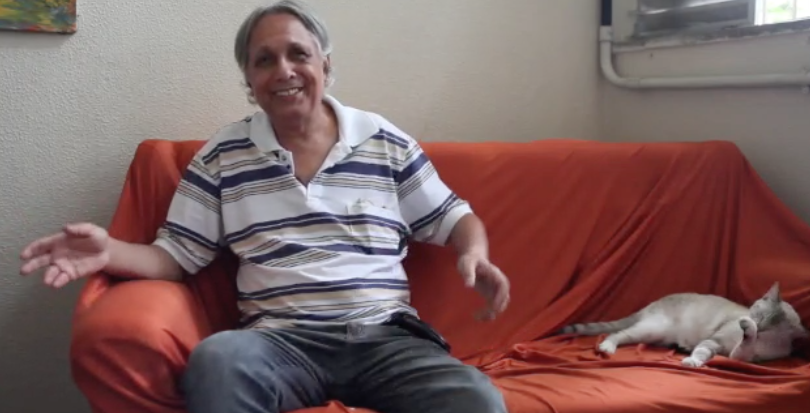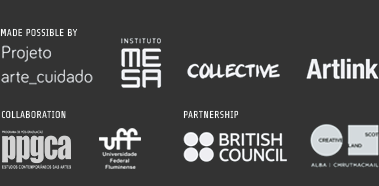
Vídeo entrevista Lula Wanderley, Instituto Municipal Nise da Silveira, 2016. Frame: Daniel Leão
Interview Lula Wanderley: Sensibility as an Instrument of Work
By Jessica Gogan
In the 1970s and 80s artist and psychiatrist Lula Wanderley collaborated with revolutionary figures in the fields of 20th Brazilian art and psychiatry: psychiatrist Nise da Silveira, critic Mário Pedrosa and the artist Lygia Clark. Radicalizing and interweaving their legacies Lula created the Espaço Aberto ao Tempo [Space Open to Time], a clinic inaugurated in 1988 in the old Pedro II Psychiatric Center (currently the Instituto Municipal Nise da Silveira) in the Engenho do Dentro neighborhood in the northern part of Rio de Janeiro. EAT soon become a reference for anti-asylum psychiatric reform movements in Brazil.
Here Wanderley developed an innovative clinical practice that he calls “poetic psychiatry” embracing the potential of the “in-between:” of process, of relationality, and of a state of “non affirmation,” that is, the position of the “and” in-between art and therapy. Here he incorporates what Lygia spoke of as the possible “magic” residing in her therapeutic experiments, the “singular state of art without art.”1 His practice also responds to what Nise da Silveira suggested to Lula at the beginning of his career, when he said that he had no vocation for medicine or psychiatry, that he should “use his sensibility as an instrument of work” and to what Mário Pedrosa had already noted in the 1950s and 60s as the only revolution, that is “the revolution of sensibility.”2
The interview is approximately 30 minutes in length including video clips illustrating various aspects of his work.
***
Lula Wanderley
Lula is an artist, born in Pernambuco, who has lived in Rio de Janeiro since 1976. In Recife he worked as a graphic artist in newspapers and magazines and experimented with visual poetry. Simultaneously, he studied medicine and graduated from the Federal University of Pernambuco. In Rio, he collaborated with Nise da Silveira at the Casa das Palmeiras, and with her and Mario Pedrosa on the project to reformulate the Museum of Images of the Unconscious, sponsored by FINEP. He has held individual exhibitions, among them A estratégia angular de um poema (CMAHO, curator Izabela Pucu, 2016) and participated in various collective exhibitions such as the recent Lugares do delírio curated by Tania Rivera. He also collaborated with Lygia Clark on her research on art / body / psychism. He created EAT in late 1980s which he continues to coordinate and where he has been working with psychotic patients for over 25 years, with the goal of constantly searching for an experimental and poetic clinical practice.
Jessica Gogan
Gogan is a curator and educator and director of the MESA Institute and co-editor of MESA Magazine. She holds a PhD in Art History from the University of Pittsburgh in the USA (2016). Her research and projects explore the interfaces between art and society focusing on practices that traverse the fields of art, curatorship and education. She recently launched the book Domingos da Criação: Uma coleção do experimental em arte e educação, a research and publication project awarded an Itaú Rumos 2016 grant, exploring the participatory happenings Domingos da Criação held at Museum of Modern Art in Rio de Janeiro in 1971. She currently co-coordinates the Art_Care Project with Izabela Pucu and is a PNPD/CAPES postdoctoral fellow in the Postgraduate Program in Contemporary Studies of the Arts at UFF.
_________
1 Lygia Clark.”A propósito da magia do objeto,” 1965. Lygia Clark, Livro Obra. The book was published in 1983 by Luciano Figueiredo and Ana Maria Arújo in a limited edition of 24.
2 The citation with respect to Nise da Silveira “use your sensibility as an instrument of work” appears at the beginning of this video interview. The Mário Pedrosa citation is from the essay “Arte e revolução”, originally published in Jornal do Brasil, April 16, 1967 in Aracy Amaral ed., Mário Pedrosa: Mundo, homem, arte em crise (São Paulo: Perspectiva, 1986) 247.



